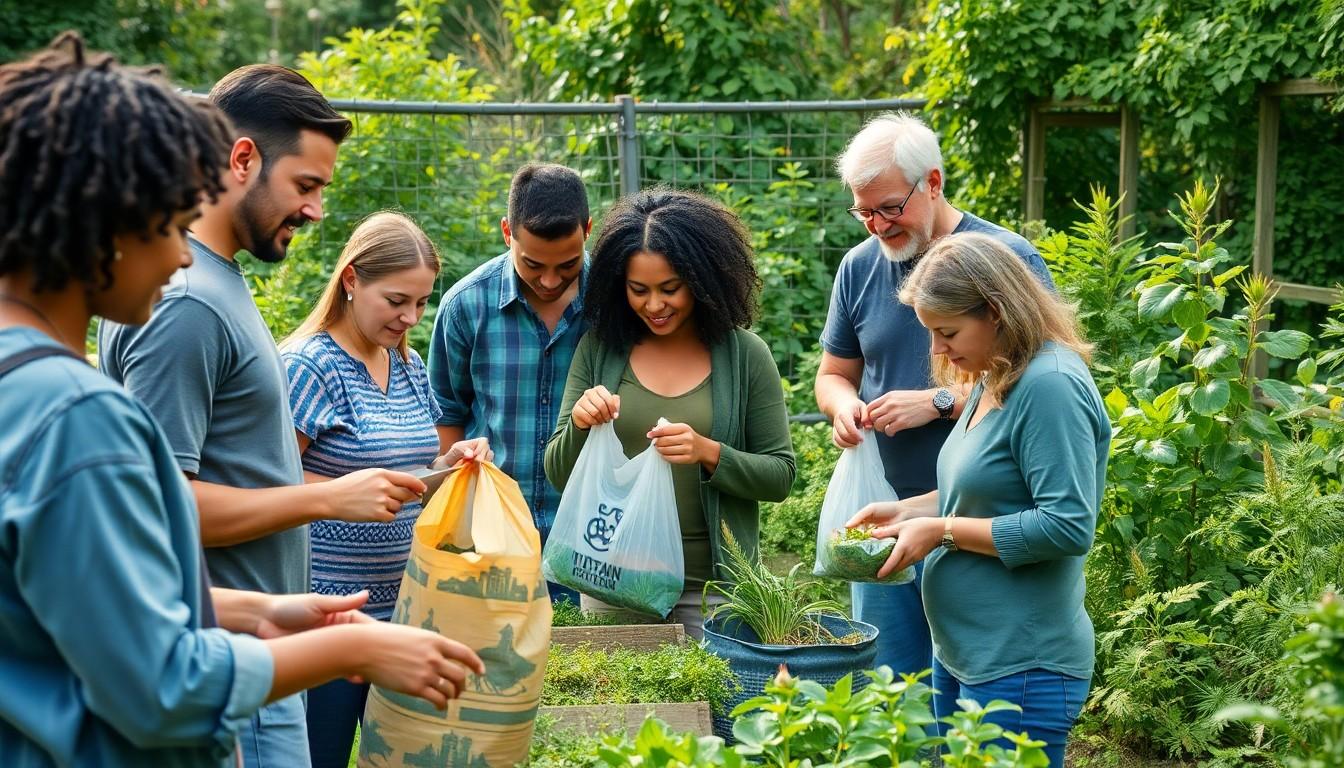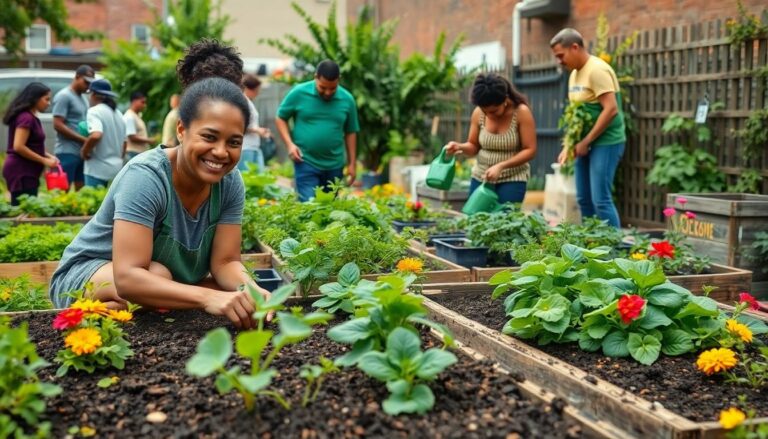In a world where plastic bags seem to multiply like rabbits and climate change feels like an unwelcome houseguest, sustainable living has become more than just a trend—it’s a necessity. Imagine a life where every choice you make not only benefits you but also gives Mother Earth a well-deserved high-five. It’s time to roll up those sleeves and dive into the delightful world of eco-friendly habits that can make a real difference.
Ways of Sustainable Living
Sustainable living focuses on minimizing one’s environmental impact through conscious choices and habits. This lifestyle promotes the health of the planet and enhances the quality of life for current and future generations.
Definition and Importance
Sustainable living refers to a way of life that reduces an individual’s or society’s use of the Earth’s natural resources. It involves practices that prioritize ecological balance, aiming to leave a more sustainable environment for future generations. Importance lies in addressing critical issues such as climate change, resource depletion, and biodiversity loss. Adopting sustainable living habits can lead to cleaner air and water, reduced waste, and healthier ecosystems. Individuals who embrace these practices contribute to a collective effort that significantly impacts the planet’s health and overall well-being.
Key Principles of Sustainability
Sustainable living rests on several core principles that guide individuals and communities. First, resource conservation emphasizes using natural resources wisely to prevent depletion. Second, waste reduction encourages minimizing, reusing, and recycling materials. Third, energy efficiency focuses on reducing energy consumption through smarter choices like using energy-efficient appliances and renewable energy sources. Fourth, sustainable transportation promotes walking, biking, and using public transport to cut down on fossil fuel use. Lastly, supporting local economies strengthens community ties while reducing carbon footprints associated with long-distance transportation of goods. Each principle plays a pivotal role in fostering a more sustainable future.
Eco-Friendly Practices

Adopting eco-friendly practices significantly contributes to sustainable living. Individuals can start with simple actions that lead to impactful change.
Reducing Waste
Reducing waste plays a critical role in sustainability. People can practice recycling, composting, and choosing products with minimal packaging. Avoiding single-use plastics helps decrease landfill contributions. Consider donating unwanted items instead of throwing them away. Using reusable bags, bottles, and containers also minimizes waste generation. Each small step accumulates, leading to a significant positive effect on the environment.
Energy Conservation
Energy conservation directly benefits both the planet and personal finances. Switching to energy-efficient appliances reduces electricity usage. Individuals can also utilize natural light instead of artificial lighting whenever possible. Unplugging devices when not in use prevents unnecessary energy drain. Implementing smart thermostat systems enhances energy management in homes. Prioritizing public transportation or carpooling further decreases reliance on fossil fuels. Every action towards energy conservation counts, contributing to a more sustainable future.
Sustainable Agriculture
Sustainable agriculture emphasizes methods that protect natural resources while maintaining farm productivity. This approach enhances soil health, conserves water, and supports biodiversity.
Organic Farming Methods
Organic farming methods use no synthetic fertilizers or pesticides. Instead, farmers rely on natural alternatives, such as compost and crop rotation, to promote plant health. Managing pests naturally enhances the ecological balance, often leading to better yields over time. The organic approach also prioritizes soil health, utilizing practices like cover cropping to build organic matter. Certified organic products witnessed a market growth of around 12.4% in 2021, highlighting consumer demand for sustainable practices.
Community Supported Agriculture (CSA)
Community Supported Agriculture (CSA) connects local farms directly to consumers. Members buy shares of the farm’s harvest, supporting sustainable methods while enjoying fresh produce. This model fosters relationships between consumers and farmers, allowing for transparency in food production. Participation in CSA programs promotes seasonal eating, reducing the carbon footprint associated with long-distance food transport. In 2020, an estimated 13,000 CSAs operated across the U.S., showcasing a growing interest in community-based agricultural initiatives.
Sustainable Transportation
Sustainable transportation plays a crucial role in reducing environmental impact. It encompasses various methods that promote efficient mobility while conserving resources.
Benefits of Public Transit
Public transit systems lower emissions by decreasing the number of individual vehicles on the road. Cities that invest in public transportation see a reduction in traffic congestion and improved air quality. Studies show that public transit saves approximately 45 million metric tons of CO2 annually in the U.S. Communities also benefit from enhanced accessibility, making it easier for individuals to reach education and job opportunities. The financial advantages are significant; households that use public transit save an average of $10,000 each year compared to those relying solely on personal vehicles.
Cycling and Walking Initiatives
Cycling and walking initiatives promote healthier lifestyles and reduce carbon footprints. Cities that implement bike lanes and pedestrian pathways often experience increased physical activity among residents. Data indicates that people who bike or walk for transportation reduce their risk of chronic diseases. Investments in cycling infrastructure can spur local economies by attracting more businesses. Moreover, urban areas with robust pedestrian-friendly designs report increased social interaction, leading to greater community engagement. Encouraging these modes of transportation ultimately supports cleaner air and vibrant neighborhoods.

Sustainable Consumption
Sustainable consumption focuses on choices that minimize negative environmental impacts. Making informed choices leads to a healthier planet.
Choosing Eco-Friendly Products
Selecting eco-friendly products reduces harm to the environment. Look for items made from renewable materials, recycled components, or biodegradable substances. Brands that prioritize sustainability often provide clear information about sourcing and production methods. Eco-labels or certifications can guide consumers in making responsible decisions. For instance, products with the Energy Star label signify energy efficiency, helping lower household energy consumption. Supporting brands committed to sustainability fosters a market for eco-conscious products, motivating others to adopt greener practices.
Supporting Local Businesses
Supporting local businesses strengthens communities and reduces carbon footprints. When purchasing from nearby shops, consumers decrease transportation emissions associated with long-distance shipping. Local businesses often provide fresh, seasonal products, enhancing both quality and taste. Engaging with these enterprises promotes job creation and keeps money circulating within the community. An example includes farmers’ markets, which connect consumers directly with local farmers, offering a variety of sustainable food options. By choosing local goods, individuals contribute to a more resilient economy while enjoying unique offerings tailored to community needs.
One Choice at a Time
Sustainable living isn’t just a choice; it’s a responsibility that everyone can embrace. By integrating eco-friendly habits into daily life, individuals can significantly contribute to a healthier planet. Each small action taken today can lead to substantial changes tomorrow.
From reducing waste and conserving energy to supporting local economies and practicing sustainable agriculture, every effort counts. As more people adopt these principles, the collective impact becomes powerful.
Choosing sustainability is about creating a brighter future for generations to come. With commitment and awareness, it’s possible to foster a world where both people and nature thrive together.




